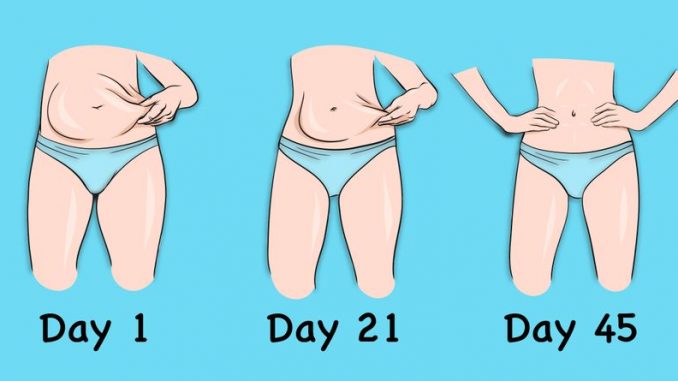
A desk job poses some serious health risks since prolonged sitting might cause obesity, diabetes, heart diseases, and even cancer. However, there are simple, but highly beneficial mini-exercises that you can do right at the desk, and burn belly fat.
These are the eight best ones:
Knee-to-Chest Lift
Benefits:
Helps digestion, burns belly fat, tones the abdominal muscles
Instructions:
Sitting with the spine straight, and the feet on the floor, hip-width apart, elevate the right knee and pull it to your chest. Then, draw the knee closer with the hands, and repeat 20 times with both legs.
Double Knee Lift
Benefits:
It strengthens the belly muscles.
Instructions:
Bring the legs together and the spine straight, hold the sides of the chair with both hands. Then, raise the knees and pull them to the chest. Put the knees down, without touching the floor, and repeat
With a straight back, lift your knees and pull them to your chest — flex your abdominal muscles.10-20 times.
Toe Touches
Benefits:
This exercise will help you burn the excess fat from the hips and belly.
Instructions:
With the feet on the floor, extend the arms in front of the body, at a shoulder height, and turn the body to the right. Then, bend, and with the right hand, touch the left foot. Hold for a few seconds, and repeat with the other hand. Make 20 repetitions.
Double Knee Lift With Side Bends
Benefits:
It shapes the waist by engaging the oblique muscles to burn fat from the sides of the belly.
Instructions:
Sitting on the edge of the chair, with a straight back, grip the armrests with the hands. Then, bend the body on one side, sit on the glute, and with the legs together, elevate the knees to the chest. Repeat on the other side. Make 10-20 repetitions.
Oblique Stretches
Benefits:
This exercise strengthens the glutes, engages the waist muscles, and tones the belly muscles.
Instructions:
Start beside the chair, put the left hand on the arm of it, and lift the right hand above the head. Raise the right leg and bend the knee so that the heel can touch the area close to the bum.
Start lowering the right hand, to touch the heel of the foot, and return to the initial position. Make 15 repetitions. Then, change the hand and the leg, and do the same on the other side.
Wooden Leg
Benefits: It will boost your lower-body strength
Instructions:
Sit in the chair, and extend one leg out straight in front of you. Hold for two seconds, and then lift it up as high as possible, and hold for two more seconds. Make 15 repetitions with both legs.
Knee-to-Elbow Lift
Benefits:
This exercise engaged the obliques and lower abdominal muscles.
Instructions:
While sitting on a chair with a straight back, and the hands behind the head, elevate the right knee to the chest. Then, twist and bend the torso in order to be able to touch the right knee with the left elbow.
Make 15 repetitions, and try the same with the right elbow and the left knee.
Full Body Lift
Benefits:
It will burn excess fat in the belly, shoulder, and back area.
Instructions:
Sitting on the chair, holding its arms, lift the body above the seat of the chair, to make the legs and hips hang in the air. Then, try to raise the knees to the chest with the help of the abdominal muscles. Hold for 15 seconds, and then lower down the legs. Make four repetitions.
Remember that you need to maintain a proper position at the desk even when you are not exercising.
According to Jason Queiros, a chiropractor at Stamford Sports & Spine, in Connecticut :
“It’s important that your desk chair be at the proper height to reduce strain on your neck and back. The chair provides the support for your body throughout the day.
Adjust the height so you’re in a 90-90-90 position; feet flat on the floor or on a footrest and your knees and hips bent at 90-degree angles.
Keep your lower spine flat against the back of the chair to maintain proper curvature. The chair will help keep the rest of your back and neck erect in order to decrease your chance of hunching forward, which can cause spasms in the back and neck and lead to headaches. The top one-third of the monitor should be above eye level, both to decrease eyestrain and to prevent hunching forward. “